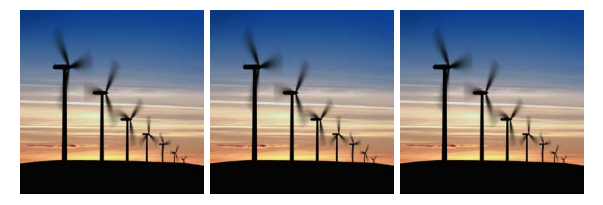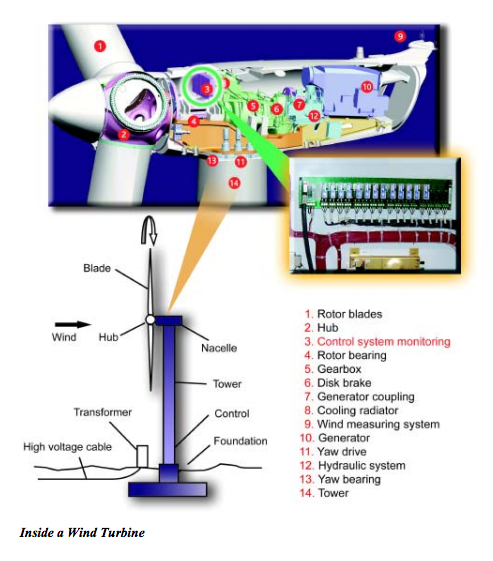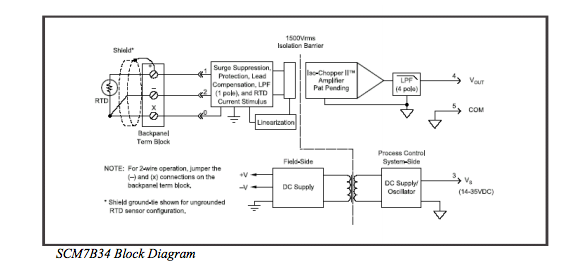an120: Wind Turbines Today
Application Note
Clean, Green, and Renewable

In today’s ongoing search for sources of alternative energy, clean, green, and renewable are top priorities. Using wind power to produce electricity is a perfect fit.
Wind is air set in motion naturally. According to Evangelista Torricelli, who first gave the correct scientific explanation in the mid 1600s, “…winds are produced by differences of air temperature, and hence density, between two regions of the earth.” The sun heats the earth unevenly because of differences in earth surfaces. The earth’s rotation is also a key factor in wind production.
Turbine Technology
Wind power is the conversion of wind energy into electricity. This is achieved using wind turbines, which convert the kinetic energy of wind into electrical energy as follows:- Wind turns propeller-like blades around a rotor.
- The rotor, which is made up of the blades and hub, causes a low-speed shaft to turn at approximately 30-60 rotations per minute (rpm).
- he low-speed shaft connects to a 2- or 3- stage speed-increasing gearbox that connects it to a high-speed shaft and increases the rpm to approximately 1000-1800 rpm. This is the rotational speed most generators require to produce electricity.
- The high-speed shaft drives a generator.
- The generator produces electricity.
The process of converting wind power to electricity is clean, environmentally sound and, as long as the sun keeps shining and winds are created, completely renewable.
Utility-Scale Wind Turbines
Utility-scale wind turbines are large and mediumsized turbines that range from about 500kW up to 6MW. The larger turbines are usually arrayed in wind farms that generate bulk energy for sale in the power market.Most commercially available utility-scale wind turbines today are built according to Danish design. This turbine configuration calls for a horizontal axis, three-bladed rotor, upwind orientation, and active yaw system to keep the rotor oriented into the wind. <>
The amount of power produced by a wind turbine is directly dependent on wind speed. In general, wind turbines start to produce power at wind speeds of approximately 4m/s (9mph), attain rated power at about 13m/s (29mph), and stop producing power at about 25m/s (56mph).
As wind speeds increase with height above the earth, wind turbines are mounted on high towers of approximately 100 feet (30 meters) or more to ensure access to more wind energy.
Wind Turbine Safety and Control
Wind turbine control and safe operation are key concerns when using wind power. Unlike virtually every other industry, wind turbines operate without direct supervision. Components are mounted at the top of the tower, where six months may go by between regularly scheduled maintenance operations. In the meantime, rotating components are generating vibration and heat that can cause parts to malfunction and fail.Wind turbines operate under a wide range of environmental conditions, including extremes such as 100% humidity and ambient temperatures from -40°C to 85°C.
They also generate high voltages and currents. Electrical components must therefore be able to withstand high surge voltages and be immune to the electrical noise that can radiate from generators and switch networks. As an indicator of how essential effective protection is, lightning rods are a prominent wind turbine feature.
In sum, the challenging environments in which wind turbines operate demand reliable and broad ranging protections.

For wind turbines to remain both operable and in safe condition, components must be accurately monitored and assessed while being continuously protected. A key aspect critical to wind turbine safety, therefore, is wind turbine control. Without effective control, wind turbines will speed up in high winds, producing much higher yields than their rated power. Overspeed will also result if critical components fail, for example, if the generator overheats or is disconnected and therefore stops braking the rotor’s rotation. Out-of-control speed is considered a runaway condition; the safety system must be able to quickly regain control of the wind turbine and stop it. This is accomplished primarily through an aerodynamic braking system that prevents the rotor blades from increasing power production, as well as a hydraulic disk brake system.
In conjunction with effective systems, wind turbine safety and control are absolutely dependent on the impeccable reliability of all parts.
The Controller
The wind turbine controller plays many roles and is at the heart of wind turbine safety and operability:- Participates in virtually all safety system decision-making processes
- Oversees normal wind turbine operations
- Monitors hundreds of different functions
- Collects statistical measurements
- Communicates with the wind turbine operator
- Provides internal communications
The controller consists of computers that monitor wind turbine conditions while also controlling particular switches, valves, hydraulic pumps, etc. Given the difficulty of accessing components, it is crucial that controllers are capable of internal monitoring and self-regulation.
There are usually controllers at the bottom of the tower and in the nacelle at the top of the tower. A third controller is found in some newer wind turbines in the hub of the rotor.
To make sure controllers provide the requisite safety and operating availability, redundant, backup systems are part of modern wind turbine design.
What is Monitored?
Sensors are used to measure as many as 500 parameters in a modern wind turbine. Conditions that can be monitored include:
- Generator voltage and current frequency
- Low-speed shaft rotational speed
- High-speed shaft rotational speed
- Wind direction and speed
- Vibration in nacelle, rotor blades, and bearings
- Hydraulic pressure
- Pitch angle of each rotor blade (for pitch controlled or active stall controlled wind turbines)
- Yaw angle
Possible temperature measurements include:
-
- Outside air temperature
- Temperature in nacelle and electronic cabinets
- Generator temperature
- Oil temperature in gearbox
- Drive shaft and gearbox bearing temperatures
Parameters measured as analog signals (temperature readings, for example) provide specific values; parameters measured as digital signals (such as correct valve function) give an on/off signal.
Dataforth Signal Conditioners
Dataforth offers the industry’s largest selection of 1000+ Instrument Class® performance isolated analog I/O signal conditioning modules. They are designed specifically to condition and protect critical data acquisition and control signals as well as sensitive connected equipment. Miniature digital I/O modules also are available to create a rugged, protective isolation barrier, effective to 4kV, between the field and the computer system.The SCM5B, SCM7B, and SensorLex®8B signal conditioning modules are all fully encapsulated, thereby ensuring they are corrosion resistant and well suited for use in rugged environments such as wind turbines.
The SCM7B34, for example, is a linearized 2-or 3- wire RTD input module whose characteristics make it ideal for temperature measurements in many wind turbine components. As shown in the figure below, the modules incorporate a five-pole filtering approach to maximize both time and frequency response by taking advantage of both Thomson (Bessel) and Butterworth characteristics. The RTD input signal is chopped by a proprietary chopper circuit, transferred across the transformer isolation barrier – suppressing transmission of common mode spikes and surges – then reconstructed and filtered for process control system output.

Dataforth signal conditioners provide ±0.03 to 0.05% accuracy and better than six sigma reliability, low output noise, high surge withstand, and a wide operating temperature range of -40°C to 85°C (most modules). In addition, Dataforth’s conditioners meet the requirements of EN61000-6-2 (ESD/RF/EFT immunity) and provide 240VAC continuous input protection, 1500Vrms transformer isolation, and ANSI/IEEE C37.90.1 transient protection. They also provide secondary protection against lightning strikes and other overvoltage events.
As a result of these outstanding features and specifications, Dataforth’s rugged, versatile signal conditioner families are the conditioners of choice to ensure rigorous wind turbine reliability requirements are met.
Dataforth References
Dataforth Corp. Websitehttp://www.dataforth.com
Was this content helpful?
Thank you for your feedback!






